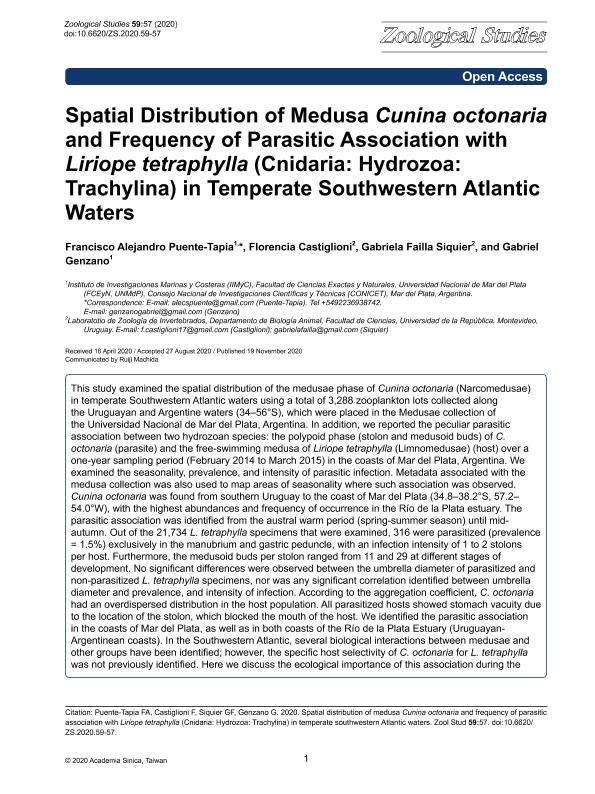Mostrar el registro sencillo del ítem
dc.contributor.author
Puente Tapia, Francisco Alejandro

dc.contributor.author
Castiglioni, Florencia
dc.contributor.author
Failla Siquier, Gabriela
dc.contributor.author
Genzano, Gabriel Nestor

dc.date.available
2021-07-15T16:14:25Z
dc.date.issued
2020-11
dc.identifier.citation
Puente Tapia, Francisco Alejandro; Castiglioni, Florencia; Failla Siquier, Gabriela; Genzano, Gabriel Nestor; Spatial distribution of medusa Cunina octonaria and frequency of parasitic association with Liriope tetraphylla (Cnidaria: Hydrozoa: Trachylina) in temperate Southwestern Atlantic waters; Academia Sinica; Zoological Studies; 59; 11-2020; 1-15
dc.identifier.issn
1021-5506
dc.identifier.uri
http://hdl.handle.net/11336/136223
dc.description.abstract
This study examined the spatial distribution of the medusae phase of Cunina octonaria (Narcomedusae) in temperate Southwestern Atlantic waters using a total of 3,288 zooplankton lots collected along the Uruguayan and Argentine waters (34-56°S), which were placed in the Medusae collection of the Universidad Nacional de Mar del Plata, Argentina. In addition, we reported the peculiar parasitic association between two hydrozoan species: the polypoid phase (stolon and medusoid buds) of C. octonaria (parasite) and the free-swimming medusa of Liriope tetraphylla (Limnomedusae) (host) over a one-year sampling period (February 2014 to March 2015) in the coasts of Mar del Plata, Argentina. We examined the seasonality, prevalence, and intensity of parasitic infection. Metadata associated with the medusa collection was also used to map areas of seasonality where such association was observed. Cunina octonaria was found from southern Uruguay to the coast of Mar del Plata (34.8-38.2°S, 57.2-54.0°W), with the highest abundances and frequency of occurrence in the Río de la Plata estuary. The parasitic association was identified from the austral warm period (spring-summer season) until midautumn. Out of the 21,734 L. tetraphylla specimens that were examined, 316 were parasitized (prevalence= 1.5%) exclusively in the manubrium and gastric peduncle, with an infection intensity of 1 to 2 stolons per host. Furthermore, the medusoid buds per stolon ranged from 11 and 29 at different stages of development. No significant differences were observed between the umbrella diameter of parasitized and non-parasitized L. tetraphylla specimens, nor was any significant correlation identified between umbrella diameter and prevalence, and intensity of infection. According to the aggregation coefficient, C. octonaria had an overdispersed distribution in the host population. All parasitized hosts showed stomach vacuity due to the location of the stolon, which blocked the mouth of the host. We identified the parasitic association in the coasts of Mar del Plata, as well as in both coasts of the Río de la Plata Estuary (Uruguayan-Argentinean coasts). In the Southwestern Atlantic, several biological interactions between medusae and other groups have been identified; however, the specific host selectivity of C. octonaria for L. tetraphylla was not previously identified. Here we discuss the ecological importance of this association during the holoplanktonic life history of the narcomedusae. Additionally, we report the southern limit of the spatial distribution of this particular parasitic association in the Southwestern Atlantic, thus increasing the knowledge of biological associations of gelatinous zooplankton (Cnidaria and Ctenophora) on Uruguayan and Argentinean coasts.
dc.format
application/pdf
dc.language.iso
eng
dc.publisher
Academia Sinica

dc.rights
info:eu-repo/semantics/openAccess
dc.rights.uri
https://creativecommons.org/licenses/by-nc-sa/2.5/ar/
dc.subject
ARGENTINE SEA
dc.subject
STOLON PHASE
dc.subject
MEDUSOID BUDS
dc.subject
LIMNOMEDUSAE
dc.subject
NARCOMEDUSAE
dc.subject.classification
Biología Marina, Limnología

dc.subject.classification
Ciencias Biológicas

dc.subject.classification
CIENCIAS NATURALES Y EXACTAS

dc.title
Spatial distribution of medusa Cunina octonaria and frequency of parasitic association with Liriope tetraphylla (Cnidaria: Hydrozoa: Trachylina) in temperate Southwestern Atlantic waters
dc.type
info:eu-repo/semantics/article
dc.type
info:ar-repo/semantics/artículo
dc.type
info:eu-repo/semantics/publishedVersion
dc.date.updated
2021-07-01T17:33:56Z
dc.journal.volume
59
dc.journal.pagination
1-15
dc.journal.pais
China

dc.journal.ciudad
Taiwan
dc.description.fil
Fil: Puente Tapia, Francisco Alejandro. Consejo Nacional de Investigaciones Científicas y Técnicas. Centro Científico Tecnológico Mar del Plata. Instituto de Investigaciones Marinas y Costeras. Subsede Instituto Nacional de Investigación y Desarrollo Pesquero; Argentina. Consejo Nacional de Investigaciones Científicas y Técnicas. Centro Científico Tecnológico Conicet - Mar del Plata. Instituto de Investigaciones Marinas y Costeras. Universidad Nacional de Mar del Plata. Facultad de Ciencias Exactas y Naturales. Instituto de Investigaciones Marinas y Costeras; Argentina
dc.description.fil
Fil: Castiglioni, Florencia. Universidad de la República; Uruguay
dc.description.fil
Fil: Failla Siquier, Gabriela. Universidad de la República; Uruguay
dc.description.fil
Fil: Genzano, Gabriel Nestor. Consejo Nacional de Investigaciones Científicas y Técnicas. Centro Científico Tecnológico Conicet - Mar del Plata. Instituto de Investigaciones Marinas y Costeras. Universidad Nacional de Mar del Plata. Facultad de Ciencias Exactas y Naturales. Instituto de Investigaciones Marinas y Costeras; Argentina. Consejo Nacional de Investigaciones Científicas y Técnicas. Centro Científico Tecnológico Mar del Plata. Instituto de Investigaciones Marinas y Costeras. Subsede Instituto Nacional de Investigación y Desarrollo Pesquero; Argentina
dc.journal.title
Zoological Studies

dc.relation.alternativeid
info:eu-repo/semantics/altIdentifier/doi/http://dx.doi.org/10.6620/ZS.2020.59-57
dc.relation.alternativeid
info:eu-repo/semantics/altIdentifier/url/http://zoolstud.sinica.edu.tw/Journals/59/59-57.html
Archivos asociados
